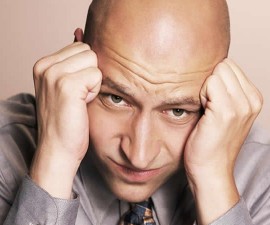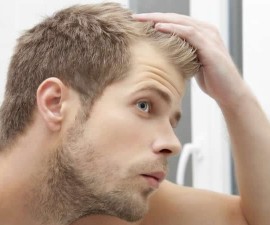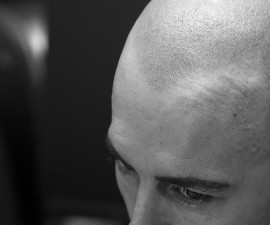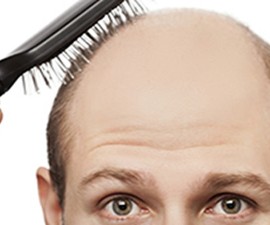Hair loss occurs for a number of different causes. But mostly, it is associated with the combination of aging and hereditary. Numerous treatments are available, and one of them is Rogaine (its generic name is Minoxidil). It is used to help treat male and female pattern baldness (androgenetic alopecia, the most common form of hair loss in men and women). But why doesn’t it work on receding hairline?
About male pattern baldness
It is a hereditary condition in which hair follicles is likely to become over sensitive to the activity of an androgen (male hormone) called DHT or dihydrotestosterone. In men with pattern baldness, DHT can affect the growing phase of their hair follicles.
Male pattern baldness usually begins with front hairline or hair on the temple of both sides that recedes. However this varies, too. Some men may first experience thinning of hair on the crown.
As the name suggests, pattern hair loss means that there is usually unique pattern of how it progresses. Hairline that recedes may cause ‘M’ shape. And if there is also thinning hair on the crown, these thinning spots eventually may form horseshoe shape or ‘U’ shape (see this picture).
How long does it take to lead to baldness can vary. If the baldness does occur, it could be partial or complete baldness.
Receding hairline is common in men, NOT for women!
It is usually associated with male pattern baldness, though not always. It can be an early sign of this hereditary hair loss. Interestingly, it is not common in women with female pattern baldness.
Although the crown can be quite shinny, female pattern baldness usually doesn’t cause receding hairline. Unlike the name suggests, it’s also less likely to cause baldness. In fact, baldness is rare in women (including for those with female pattern baldness).
Typically, women with this pattern hair loss tend to experience thinning of hair on the entire scalp. And there is usually no noticeable bald spot.
Another key point, the underlying cause may be slightly different. Still, genetic and aging have a role. But it’s less likely to be associated with the activity of DHT. Even some recent studies have clearly confirmed that there is no link between androgen (DHT) and female pattern baldness.
The history of Rogaine
It belongs to a group of vasodilator medication. In the past, it was used to help treat people with hypertension (high blood pressure). Vasodilator itself means medication to open ‘dilate’ the blood vessel. But many those who took it for treating hypertension also experienced excess hair growth.
At first, this side effect didn’t bother a lot especially for those with hair loss problem. But hair growth also occurred on the unexpected areas such as back and chest.
But the magic of science answered. With some modifications, the scientists successfully changed it for hair loss treatment with two options; solution and foam. Unexpected hair growth on the wrong areas can be eliminated if the treatment is applied topically.
Unfortunately, the exact way of how it treats hair loss and stimulates hair growth still remains puzzling. There is also no adequate evidence that any vasodilator has an effect on hair follicle.
Rogaine has been officially approved for female pattern baldness
It has been tested through some clinical studies that it works for treating female pattern baldness. Even it also has been approved by FDA (the Food and Drug Administration).
Like other hair loss treatments, the result can also vary. But most women find that it is worth a try. The improvement of hair growth can be clearly noticed within a few months after taking the treatment.
For more in-depth information about Rogaine or Minoxidil for women, you can visit this section!
Does it also work for male pattern baldness?
Rogaine is also one of approved treatments for men with pattern baldness. Some men use it to help stimulate hair growth and slow hair loss.
As noted before, male pattern baldness is usually linked to the activity of DHT. And Rogaine has nothing to do with DHT. But some experts think that it may work by shortening the resting (telogen) phase of hair follicle.
The use of 2 percent Minoxidil for hair loss treatment was first approved for men in 1988 – and in 1992 for women. Today, the stronger dosage is also available. It is now available in 5 percent strength, too.
Does it work for receding hairline?
While Rogaine is one of treatment options for male pattern baldness, but it is not too recommended for receding hairline. And this may be distressing for scientists.
The way of why hairline can recede is not fully known, too. The same goes for the answer of how Rogaine works in treating hair loss. Scientists may need to find these answers first!
Instead, propecia (another approved treatment for male pattern baldness) is more recommended. Even it’s thought that this hair loss treatment is better than Rogaine.
Propecia (its generic name is Finasteride) can help reduce and control DHT, the underlying cause of male pattern baldness in most cases. In history, it is the first treatment that can effectively treat male pattern baldness.
It is the second treatment approved for androgenetic alopecia. It was approved by FDA in1997. Today, it is the first treatment choice to treat early sign of male pattern baldness (including for receding hairline). See more about propecia in here!
Why doesn’t Rogaine work on receding hairline?
Again, Rogaine is currently not approved yet for treating any hairline that recedes. Unfortunately, the reason of why it doesn’t work for receding hairline is not fully understood yet.
However there are some explanations. These include:




